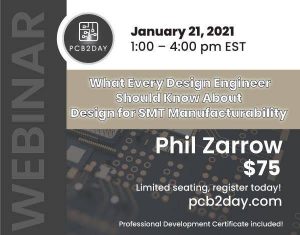What Every Design Engineer Should Know About Design for SMT Manufacturability
Course Title: What Every Design Engineer Should Know About Design for SMT Manufacturability
Course Instructor(s): Phil Zarrow
Duration: 3 Hours
Objectives of the Course:
 Providing a printed circuit design that can be cost effectively reproduced and converted into a high-quality, reliable, functional electronic product requires that the designer have a grasp of the total assembly process. CAD programs have come a long way towards recognizing assembly process(es) requirements but there still remains major gaps that result in defects and inefficiency. Thus, in addition to designing for speed, frequency and packaging requirements, the successful designer must be knowledgeable with respect to the characteristics and capabilities of the SMT assembly process including soldering (SMT and through-hole) and placement.
Providing a printed circuit design that can be cost effectively reproduced and converted into a high-quality, reliable, functional electronic product requires that the designer have a grasp of the total assembly process. CAD programs have come a long way towards recognizing assembly process(es) requirements but there still remains major gaps that result in defects and inefficiency. Thus, in addition to designing for speed, frequency and packaging requirements, the successful designer must be knowledgeable with respect to the characteristics and capabilities of the SMT assembly process including soldering (SMT and through-hole) and placement.
This on-site course is intended to provide the participant an understanding of how Design issues interacts with the SMT assembly processes and the design issues associated with manufacturing them. How the design effects manufacturing capability and vice versa will be covered in depth.
Register at www.pcb2day.com
Webinar Outline:
Introduction: Effects of NO DFM – why what the Designer does is so consequential to optimized assembly yields and reliability.
- Design Impact on SMT Assembly
- PCB Surface Finish Considerations
- The advantages and disadvantages of different surface finishes including OSP, HASL, ENIG, ENIPG, ImAg, and ImSn
- SMT Printing Considerations
- Solder Paste
- Flux and alloy composition and effect on interconnections
- Stencil Design
- Importance of aperture Area Ratio and “5-Ball Rule” discussed regarding quality of solder joints. Patterns and considerations for aperture geometries for various components, including micro-passives, BTCs, and Ultra-fine pitch
- Component Placement
- The “mechanics” of pick-and-place including feeders, pick-up tooling and vision systems. The consideration and accommodations for micro-passives are presented
- Reflow
- The reflow profile is examined with the effects of component mass, location and surface geometry considered
- Through-hole Considerations
- Wave and Selective Soldering principles and the requirement for proper design considerations as a “make it or break it”.
Discussion: Questions and Answers
What You Will Learn:
- An understanding of the SMT assembly process
- How the PCB design impacts the assembly processes
- How designing for manufacturability results in higher efficiency in assembly as well as higher yields
- Manufacturing implications of emerging technologies including BTCs, Ultra-miniature passives, and ultra-fine pitch IC packages.
Who Should Attend:
This course is essential for Design Engineers, as well as Manufacturing, Process, Test and Quality Engineering personnel and Management who want to become more familiar and comfortable with the Design for Manufacturability best practices and impact on the SMT assembly process.











